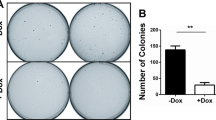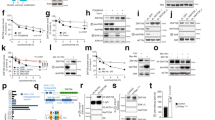Abstract
The RAS protooncogene has a central role in regulation of cell proliferation, and point mutations leading to oncogenic activation of Ras occur in a large number of human cancers. Silencing of tumor-suppressor genes by DNA methyltransferase 1 (Dnmt1) is essential for oncogenic cellular transformation by Ras, and Dnmt1 is overexpressed in numerous human cancers. Here we provide new evidence that the pleiotropic regulator of G protein signaling (RGS) family member RGS6 suppresses Ras-induced cellular transformation by facilitating Tip60-mediated degradation of Dmnt1 and promoting apoptosis. Employing mouse embryonic fibroblasts from wild-type and RGS6−/− mice, we found that oncogenic Ras induced upregulation of RGS6, which in turn blocked Ras-induced cellular transformation. RGS6 functions to suppress cellular transformation in response to oncogenic Ras by downregulating Dnmt1 protein expression leading to inhibition of Dnmt1-mediated anti-apoptotic activity. Further experiments showed that RGS6 functions as a scaffolding protein for both Dnmt1 and Tip60 and is required for Tip60-mediated acetylation of Dnmt1 and subsequent Dnmt1 ubiquitylation and degradation. The RGS domain of RGS6, known only for its GTPase-activating protein activity toward Gα subunits, was sufficient to mediate Tip60 association with RGS6. This work demonstrates a novel signaling action for RGS6 in negative regulation of oncogene-induced transformation and provides new insights into our understanding of the mechanisms underlying Ras-induced oncogenic transformation and regulation of Dnmt1 expression. Importantly, these findings identify RGS6 as an essential cellular defender against oncogenic stress and a potential therapeutic target for developing new cancer treatments.
This is a preview of subscription content, access via your institution
Access options
Subscribe to this journal
Receive 50 print issues and online access
$259.00 per year
only $5.18 per issue
Buy this article
- Purchase on Springer Link
- Instant access to full article PDF
Prices may be subject to local taxes which are calculated during checkout




Similar content being viewed by others
References
Dohlman HG, Thorner J . RGS proteins and signaling by heterotrimeric G proteins. J Biol Chem 1997; 272: 3871–3874.
Berman DM, Gilman AG . Mammalian RGS proteins: barbarians at the gate. J Biol Chem 1998; 273: 1269–1272.
Ross EM, Wilkie TM . GTPase-activating proteins for heterotrimeric G proteins: regulators of G protein signaling (RGS) and RGS-like proteins. Annu Rev Biochem 2000; 69: 795–827.
Dorsam RT, Gutkind JS . G-protein-coupled receptors and cancer. Nat Rev Cancer 2007; 7: 79–94.
Berman DM, Wang Y, Liu Z, Dong Q, Burke LA, Liotta LA et al. A functional polymorphism in RGS6 modulates the risk of bladder cancer. Cancer Res 2004; 64: 6820–6826.
Maity B, Yang J, Huang J, Askeland RW, Bera S, Fisher RA . Regulator of G protein signaling 6 (RGS6) induces apoptosis via a mitochondrial-dependent pathway not involving its GTPase-activating protein activity. J Biol Chem 2011; 286: 1409–1419.
Huang J, Yang J, Maity B, Mayuzumi D, Fisher RA . Regulator of G protein signaling 6 mediates doxorubicin-induced ATM and p53 activation by a reactive oxygen species-dependent mechanism. Cancer Res 2011; 71: 6310–6319.
Liu Z, Fisher RA . RGS6 interacts with DMAP1 and DNMT1 and inhibits DMAP1 transcriptional repressor activity. J Biol Chem 2004; 279: 14120–14128.
Bestor TH . The DNA methyltransferases of mammals. Hum Mol Genet 2000; 9: 2395–2402.
Leonhardt H, Cardoso MC . DNA methylation, nuclear structure, gene expression and cancer. J Cell Biochem 2000 (Suppl ) 35: 78–83.
Patra SK, Patra A, Zhao H, Dahiya R . DNA methyltransferase and demethylase in human prostate cancer. Mol Carcinog 2002; 33: 163–171.
Li LC, Okino ST, Dahiya R . DNA methylation in prostate cancer. Biochim Biophys Acta 2004; 1704: 87–102.
Lopez-Serra L, Ballestar E, Fraga MF, Alaminos M, Setien F, Esteller M . A profile of methyl-CpG binding domain protein occupancy of hypermethylated promoter CpG islands of tumor suppressor genes in human cancer. Cancer Res 2006; 66: 8342–8346.
Ordway JM, Williams K, Curran T . Transcription repression in oncogenic transformation: common targets of epigenetic repression in cells transformed by Fos, Ras or Dnmt1. Oncogene 2004; 23: 3737–3748.
Patra SK . Ras regulation of DNA-methylation and cancer. Exp Cell Res 2008; 314: 1193–1201.
Patra SK, Szyf M . DNA methylation-mediated nucleosome dynamics and oncogenic Ras signaling: insights from FAS, FAS ligand and RASSF1A. Febs J 2008; 275: 5217–5235.
Esteller M . Aberrant DNA methylation as a cancer-inducing mechanism. Annu Rev Pharmacol Toxicol 2005; 45: 629–656.
el-Deiry WS, Nelkin BD, Celano P, Yen RW, Falco JP, Hamilton SR et al. High expression of the DNA methyltransferase gene characterizes human neoplastic cells and progression stages of colon cancer. Proc Natl Acad Sci USA 1991; 88: 3470–3474.
He S, Wang F, Yang L, Guo C, Wan R, Ke A et al. Expression of DNMT1 and DNMT3a are regulated by GLI1 in human pancreatic cancer. PLoS One 2011; 6: e27684.
Nakagawa T, Kanai Y, Saito Y, Kitamura T, Kakizoe T, Hirohashi S . Increased DNA methyltransferase 1 protein expression in human transitional cell carcinoma of the bladder. J Urol 2003; 170: 2463–2466.
Saito Y, Kanai Y, Nakagawa T, Sakamoto M, Saito H, Ishii H et al. Increased protein expression of DNA methyltransferase (DNMT) 1 is significantly correlated with the malignant potential and poor prognosis of human hepatocellular carcinomas. Int J Cancer 2003; 105: 527–532.
Etoh T, Kanai Y, Ushijima S, Nakagawa T, Nakanishi Y, Sasako M et al. Increased DNA methyltransferase 1 (DNMT1) protein expression correlates significantly with poorer tumor differentiation and frequent DNA hypermethylation of multiple CpG islands in gastric cancers. Am J Pathol 2004; 164: 689–699.
Peng DF, Kanai Y, Sawada M, Ushijima S, Hiraoka N, Kosuge T et al. Increased DNA methyltransferase 1 (DNMT1) protein expression in precancerous conditions and ductal carcinomas of the pancreas. Cancer Sci 2005; 96: 403–408.
Zhu YM, Huang Q, Lin J, Hu Y, Chen J, Lai MD . Expression of human DNA methyltransferase 1 in colorectal cancer tissues and their corresponding distant normal tissues. Int J Colorectal Dis 2007; 22: 661–666.
Serrano M, Lin AW, McCurrach ME, Beach D, Lowe SW . Oncogenic ras provokes premature cell senescence associated with accumulation of p53 and p16INK4a. Cell 1997; 88: 593–602.
Pakneshan P, Szyf M, Rabbani SA . Methylation and inhibition of expression of uPA by the RAS oncogene: divergence of growth control and invasion in breast cancer cells. Carcinogenesis 2005; 26: 557–564.
Pruitt K, Ulku AS, Frantz K, Rojas RJ, Muniz-Medina VM, Rangnekar VM et al. Ras-mediated loss of the pro-apoptotic response protein Par-4 is mediated by DNA hypermethylation through Raf-independent and Raf-dependent signaling cascades in epithelial cells. J Biol Chem 2005; 280: 23363–23370.
Syeda F, Fagan RL, Wean M, Avvakumov GV, Walker JR, Xue S et al. The replication focus targeting sequence (RFTS) domain is a DNA-competitive inhibitor of Dnmt1. J Biol Chem 2011; 286: 15344–15351.
Fagan RL, Cryderman DE, Kopelovich L, Wallrath LL, Brenner C . Laccaic acid A is a direct, DNA-competitive inhibitor of DNA methyltransferase 1. J Biol Chem 2013; 288: 23858–23867.
Santi DV, Norment A, Garrett CE . Covalent bond formation between a DNA-cytosine methyltransferase and DNA containing 5-azacytosine. Proc Natl Acad Sci USA 1984; 81: 6993–6997.
Geutjes EJ, Bajpe PK, Bernards R . Targeting the epigenome for treatment of cancer. Oncogene 2012; 31: 3827–3844.
Maslov AY, Lee M, Gundry M, Gravina S, Strogonova N, Tazearslan C et al. 5-Aza-2'-deoxycytidine-induced genome rearrangements are mediated by DNMT1. Oncogene 2012; 31: 5172–5179.
Cox AD, Der CJ . The dark side of Ras: regulation of apoptosis. Oncogene 2003; 22: 8999–9006.
Santourlidis S, Warskulat U, Florl AR, Maas S, Pulte T, Fischer J et al. Hypermethylation of the tumor necrosis factor receptor superfamily 6 (APT1, Fas, CD95/Apo-1) gene promoter at rel/nuclear factor kappaB sites in prostatic carcinoma. Mol Carcinog 2001; 32: 36–43.
Reu FJ, Bae SI, Cherkassky L, Leaman DW, Lindner D, Beaulieu N et al. Overcoming resistance to interferon-induced apoptosis of renal carcinoma and melanoma cells by DNA demethylation. J Clin Oncol 2006; 24: 3771–3779.
Chen M, Shabashvili D, Nawab A, Yang SX, Dyer LM, Brown KD et al. DNA methyltransferase inhibitor, zebularine, delays tumor growth and induces apoptosis in a genetically engineered mouse model of breast cancer. Mol Cancer Ther 2012; 11: 370–382.
Xu M, Gao J, Du YQ, Gao DJ, Zhang YQ, Li ZS et al. Reduction of pancreatic cancer cell viability and induction of apoptosis mediated by siRNA targeting DNMT1 through suppression of total DNA methyltransferase activity. Mol Med Report 2010; 3: 699–704.
Seaberg RM, van der Kooy D . Adult rodent neurogenic regions: the ventricular subependyma contains neural stem cells, but the dentate gyrus contains restricted progenitors. J Neurosci 2002; 22: 1784–1793.
Maity B, Stewart A, O'Malley Y, Askeland RW, Sugg SL, Fisher RA . Regulator of G protein signaling 6 (RGS6) is a novel suppressor of breast tumor initiation and progression. Carcinogenesis 2013; 34: 1747–1755.
Du Z, Song J, Wang Y, Zhao Y, Guda k, Yang S et al. DNMT1 stability is regulated by proteins coordinating deubiquitination and acetylation-driven ubiquitination. Sci Signal 2010; 3: ra80.
Li Q, Lin S, Wang X, Lian G, Lu Z, Guo H et al. Axin determines cell fate by controlling the p53 activation threshold after DNA damage. Nat Cell Biol 2009; 11: 1128–1134.
Martemyanov KA, Yoo PJ, Skiba NP, Arshavsky VY . R7BP, a novel neuronal protein interacting with RGS proteins of the R7 family. J Biol Chem 2005; 280: 5133–5136.
Cabrera JL, de Freitas F, Satpaev DK, Slepak VZ . Identification of the Gbeta5-RGS7 protein complex in the retina. Biochem Biophys Res Commun 1998; 249: 898–902.
Cheever ML, Snyder JT, Gershburg S, Siderovski DP, Harden TK, Sondek J . Crystal structure of the multifunctional Gbeta5-RGS9 complex. Nat Struct Mol Biol 2008; 15: 155–162.
Liu Z, Chatterjee TK, Fisher RA . RGS6 interacts with SCG10 and promotes neuronal differentiation. Role of the G gamma subunit-like (GGL) domain of RGS6. J Biol Chem 2002; 277: 37832–37839.
Maity B, Stewart A, Yang J, Loo L, Sheff D, Shepherd AJ et al. Regulator of G protein signaling 6 (RGS6) protein ensures coordination of motor movement by modulating GABAB receptor signaling. J Biol Chem 2012; 287: 4972–4981.
Acknowledgements
We thank Dr John Koland for his careful reading of and useful suggestions for this manuscript, and Sara Reed for identifying effective Tip60 small hairpin RNAs for our assays. This project was supported by National Cancer Institute grants and contracts CA161882 (RAF), HHSN261200433000C (CB), CA075954 (CB), CA090367 (DEQ) and American Cancer Society (PF-11-141-01 (RLF)).
Author information
Authors and Affiliations
Corresponding author
Ethics declarations
Competing interests
The authors declare no conflict of interest.
Additional information
Supplementary Information accompanies this paper on the Oncogene website
Supplementary information
Rights and permissions
About this article
Cite this article
Huang, J., Stewart, A., Maity, B. et al. RGS6 suppresses Ras-induced cellular transformation by facilitating Tip60-mediated Dnmt1 degradation and promoting apoptosis. Oncogene 33, 3604–3611 (2014). https://doi.org/10.1038/onc.2013.324
Received:
Revised:
Accepted:
Published:
Issue Date:
DOI: https://doi.org/10.1038/onc.2013.324
Keywords
This article is cited by
-
RGS6 drives cardiomyocyte death following nucleolar stress by suppressing Nucleolin/miRNA-21
Journal of Translational Medicine (2024)
-
Regulator of G protein signaling protein 6 alleviates acute lung injury by inhibiting inflammation and promoting cell self-renewal in mice
Cellular & Molecular Biology Letters (2023)
-
Function and regulation of RGS family members in solid tumours: a comprehensive review
Cell Communication and Signaling (2023)
-
RGS7 balances acetylation/de-acetylation of p65 to control chemotherapy-dependent cardiac inflammation
Cellular and Molecular Life Sciences (2023)
-
RGS6 suppresses TGF-β-induced epithelial–mesenchymal transition in non-small cell lung cancers via a novel mechanism dependent on its interaction with SMAD4
Cell Death & Disease (2022)



